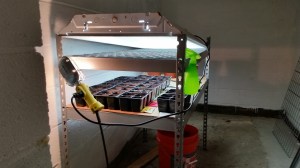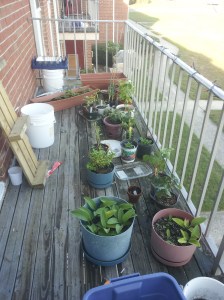Many conventional garden vegetables are too delicate to start directly outside unless you wait until late in the year, at which point you might be too late, and would naturally have a certain percentage of your plants die or never sprout from seed if you plant directly into the ground. This is especially a concern if you have limited garden space; you don’t want to plant seeds planning on everything surviving until adulthood, then losing one of three tomato plants, or your only squash vine.
Most conventional gardeners follow one of two paths, buy baby plants from a nursery, or grow your own transplants from seed. Buying baby plants from a nursery (or worse, a box store like home depot or lowes – I know, they are convenient) does make the garden easier for the casual gardener, but at 3-5 dollars per plant, you wind up not saving that much money from just buying produce from a grocery store or farmers market after you consider all of the work you put into it. This is a good course for people trying a garden for the first time, you don’t want to overwhelm yourself and should focus on a few skills at a time, like keeping the plants alive.
However, if you are already familiar with gardening, you should consider starting plants from seed. You can get 20-50 seeds for the price of one grown plant from a nursery, and can over-plant and afford to screw up. Even if 80% of your seedlings die, you are still ahead financially and have learned a new skill. It is important to start more plants than you will need, assume a few will die and that way you can keep the strongest/healthiest looking plants for yourself and then give away or sell the few extra that you have when you are ready to transplant into the garden.
Most seed packets will have basic starting instructions on them, but you can also always look online. Germination can take from a few days to a few weeks before you start to see little spots of green in your seed beds. Most transplants usually need 6-8 weeks before they are ready to go into the garden, so March is usually a good time to start them. Most plants (there are a few exceptions) need a lot of light and warmth. Considering most grow lights are not as powerful as the sun, the closer the light is to the seeds, the better. I’m talking 4-6 inches away. The further the light is from your plants, the less light they get, causing them to grow super fast to reach the light to survive, becoming “leggy”. This is not healthy for them, as they become very tall and weak/flimsy. You should make your lights adjustable, if possible, and raise the light as your plants grow. Give them at least 14 hrs of light a day to start. Most Halogen lights will work fairly well and are inexpensive, or you can buy grow lights specifically for growing plants indoors.
Keep an eye daily on your plants and follow specific instructions for each type, don’t over/under water them, and try to stay close to their ideal germination temperature; most plants like to be around 70+F, but some prefer cooler around 60F. As your plants start to grow, try to blow on them, or place a gentle fan in front of them for a few minutes a day. This will strengthen their stems to accustom them to the breeze outside.
About a week before you intend to plant them, you must “harden them off”. This is like an initiation or adjustment to living outdoors. You must put them outside under indirect sunlight for a half hour or so each day, gradually increasing the time they spend outside until they are accustomed to the brighter sunlight and wind.
I started my own tomatoes, peppers, and several medicinal/beneficial herbs. The tomatoes took off right away, but the bell peppers took four weeks to sprout, with low germination rates. I didn’t get any of my rosemary, hot peppers, lemon balm, or marshmallow to germinate, and i got terrible rates on my dill seeds. Considering I was gone for two weeks and had everything on automation, I think it isn’t that bad for my first year really trying to do this. Some didn’t get watered properly and dried out, but I am fairly sure that most of my failure was due to it being too cold. Next year i will have to use some sort of heating tray to keep the soil warm if I do this in the basement.






